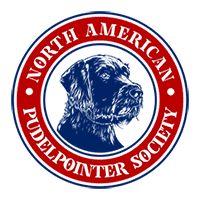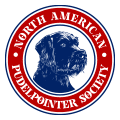NORTH AMERICAN PUDELPOINTER SOCIETY BREED STANDARD
Utilization
A versatile working gundog with all the aptitude required for the breed for a variety of work in the fields, woods and water.
General Appearance
The over-all picture should be that of an agile, versatile hunting dog with sufficient height, standing over plenty of ground. The dog should look powerful, taut with grace and nobility. A pointing dog of heavy type with an appropriate length coat of brown, black or dead leaf color protecting the whole body.
Temperament
His character should indicate enthusiasm for work, keenness, spark, and strong nerves.
Neither shy nor aggressive. Calm, self-controlled even temperament with distinct hunting
instinct without game or gun shyness.
Coat and Color
Coat dense and hard, rather tight to the body with fine woolly undercoat. Brown, Black or Dead Leaf. Minimal white is permitted, such as a blaze on the chest and/or white feet. A top coat length of 1.5 inches at the withers is an ideal medium length. By its density and harshness the coat should provide as good a protection as possible against weather and injuries as possible.
Head
Of balanced length and width, in proportion to the size and the sex of the dog.
CRANIAL REGION:
Skull: Flat, slightly rounded at the sides only, moderately broad, pronounced superciliary ridges.
Stop: Pronounced.
FACIAL REGION:
Nose: Strongly pigmented corresponding to the coat color. Nostrils well opened.
Muzzle: In balanced proportion of length and width, neither narrow nor pointed, bridge of nose straight.
Lips: Close-fitting, not overhanging; never slavering.
Jaws/teeth: Large teeth; powerful jaws with perfect, regular and complete scissor bite with the upper teeth closely overlapping the lower teeth and set square to the jaws. 42 teeth according to the dentition formula.
Eyes: Set at the sides, large, of a dark amber or brown color, with lively expression. Eye rims well covered with hair, close-fitting to the eyeball.
Ears: Of medium size, set on high, flat lying, not fleshy; well covered with hair, with rounded tips.
Neck
Of medium length, strongly muscled, slightly arched nape, no dewlap.
Body
Topline: Straight.
Withers: Pronounced.
Back: Short and straight, firm, strongly muscled.
Loins: Well-muscled.
Croup: Of medium length, slightly sloping; well-muscled.
Chest: Broad, deep; ribs well arched, but not barrel-shaped.
Underline and belly: Slight tuck up towards the rear in an elegant curve; slender.
Forequarters
General appearance: Viewed from the front, straight and parallel; viewed from the side, straight legs set well under the body. Strong bones and joints.
Shoulders: Tight fitting, well-muscled shoulder blades, forming a good angle with the upper arm.
Upper arm: Long, with good lean muscles.
Elbows: Set well under and close to the body, turning neither in nor out.
Forearm: Long, well-muscled, lean, and perpendicular to the ground. Forming a good angle with the upper arm.
Carpal joint: Strong.
Pasterns: Slightly sloping
Front feet: Round to oval, well knit; with tough and robust pads; hairs on feet and toes not too long.
Hindquarters
General appearance: Viewed from behind, legs straight and parallel, well-muscled; strong bones.
Upper thigh: Long, broad, well-muscled.
Stifle: Strong. Upper and lower thigh forming a good angle.
Lower thigh: Strong, sinewy, muscular.
Hock joint: Strong, very well angulated.
Metatarsus: Short, perpendicular to the ground.
Hind feet: Round to oval, well knit; with tough, robust pads. Hairs on feet and toes not too long.
Tail
Tail docked leaving two-thirds, carried level or upright with no feathering but covered with hard dense hair.
Gait / Movement: Harmonious, springy, with good reach and drive; far reaching strides, straight and parallel coming and going; with well upstanding posture.
Skin: Tight, close-fitting, without folds.
Size: Height at withers: Dogs: 24 to 27 inches. Bitches: 22 to 25 inches.
Weight: 45 to 75 pounds
Faults
- Deviations from the above standard are considered faults, unless listed in the table of disqualifications below. Breeders should exercise care when considering breedings, to correct faults.
- Coat too long, too soft or too open
- Pigmentation too light
- Butt bite
- Cross bite
- No beard
Disqualifications
- Over bite, under bite, and/or wry bite
- Solid white patches on body. (Minimal white is permitted, such as a blaze on the chest and/or white feet.)
- Entropic or Ectropic eyelids
- Temperament disorders; such as gun shy, shy or too aggressive
- Monorchid or Cryptorchid
- Diagnosed hip dysplasia

